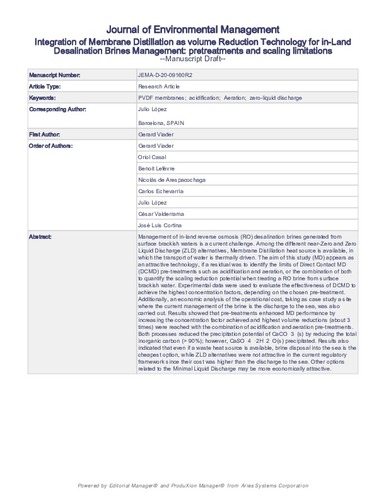Integration of membrane distillation as volume reduction technology for in-land desalination brines management: Pre-treatments and scaling limitations

Visualitza/Obre
10.1016/j.jenvman.2021.112549
Inclou dades d'ús des de 2022
Cita com:
hdl:2117/346975
Tipus de documentArticle
Data publicació2021-07
Condicions d'accésAccés obert
Llevat que s'hi indiqui el contrari, els
continguts d'aquesta obra estan subjectes a la llicència de Creative Commons
:
Reconeixement-NoComercial-SenseObraDerivada 3.0 Espanya
Abstract
Management of in-land reverse osmosis (RO) desalination brines generated from surface brackish waters is a current challenge. Among the different near-Zero and Zero Liquid Discharge (ZLD) alternatives, Membrane Distillation (MD), in which the transport of water is thermally driven, appears as an attractive technology if a residual heat source is available. The aim of this study was to identify the limits of Direct Contact MD (DCMD) pre-treatments such as acidification and aeration, or the combination of both to quantify the scaling reduction potential when treating a RO brine from surface brackish water. Experimental data were used to evaluate the effectiveness of DCMD to achieve the highest concentration factors, depending on the chosen pre-treatment. Additionally, an economic analysis of the operational cost, taking as case study a site where the current management of the brine is the discharge to the sea, was also carried out. Results showed that pre-treatments enhanced MD performance by increasing the concentration factor achieved and highest volume reductions (about 3 times) were reached with the combination of acidification and aeration pre-treatments. Both processes reduced the precipitation potential of CaCO3(s) by reducing the total inorganic carbon (>90%); however, CaSO4·2H2O(s) precipitated. Results also indicated that even if a waste heat source is available, brine disposal into the sea is the cheapest option, while ZLD alternatives were not attractive in the current regulatory framework since their cost was higher than the discharge to the sea. Other options related to the Minimal Liquid Discharge may be more economically attractive.
CitacióViader, G. [et al.]. Integration of membrane distillation as volume reduction technology for in-land desalination brines management: Pre-treatments and scaling limitations. "Journal of environmental management", Juliol 2021, vol. 289, p. 112549:1-112549:16.
ISSN0301-4797
Versió de l'editorhttps://www.sciencedirect.com/science/article/pii/S0301479721006113
| Fitxers | Descripció | Mida | Format | Visualitza |
|---|---|---|---|---|
| JEMA-D-20-09160_R2.pdf | 6,720Mb | Visualitza/Obre |


